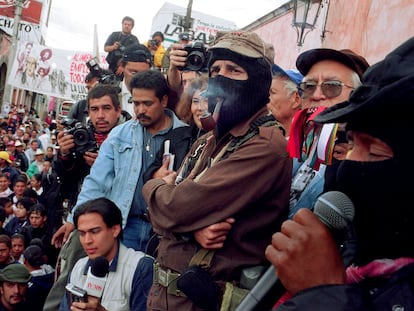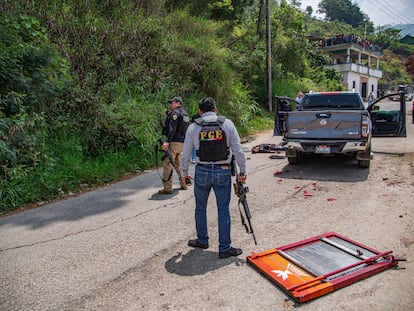And they shouted ‘enough’: The 30-year-long Indigenous uprising that rewrote Mexican history
The Zapatista Army of National Liberation is celebrating the anniversary of the armed uprising that shook the Mexican status quo. From 12 days of war in 1994 to the failed negotiations with the government, from broken promises to building autonomy, the most iconic anti-globalization guerrilla movement has survived three decades


The seams burst into the air. It was a murmur hidden for years. Centuries of rage, deep in the Lacandon Jungle, in the mountains, the villages, the cornfields. An open secret, cooked over slow fire. The dispossessed, without a decent roof over their heads; without land, without work, without healthcare, without food, without education, without freedom, without rights, without peace, without justice. Nobody expected the uprising, because nobody wanted to listen to them. “Them” being the ones who always died quietly, without a fuss.
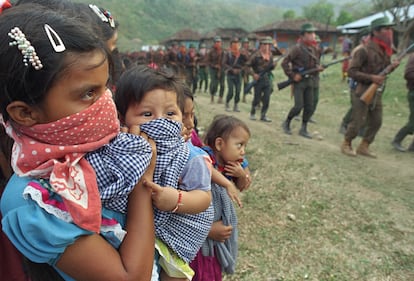
“Today, we say ‘enough!’”
30 years ago, a faceless army came down from the mountains, armed with old rifles and machetes. It was Saturday, the first day of January, 1994. Columns of Indigenous Tzotzils, Tzeltales, Choles, Tojolabales, Mames and Zoques, their faces hidden behind red headscarves, looked defiantly at the cameras. The guerilla group took over the main municipalities of Chiapas, the poorest state in Mexico: San Cristóbal de Las Casas, Altamirano, Las Margaritas, Ocosingo, Oxchuc, Huixtán and Chana. They shouted everything that they had said for years without anyone listening to them. They demanded the withdrawal of the Mexican government. And, at that moment, everyone turned to look at them.
They say that, on New Year’s Eve of 1994, Mexican President Carlos Salinas de Gortari was celebrating the great triumph of his administration. That day, the North American Free Trade Agreement (NAFTA) came into force, the culmination of a neoliberal shift after a six-year-long period marked by privatizations.
Someone warned the president that a group of Indigenous people was rising up in the South. Nobody knew who the insurgents were, nor what they wanted. Years earlier, both the U.S. and Mexican intelligence agencies had detected the presence of a group of armed peasants in Chiapas. Still, they hadn’t paid attention to the clues planted since 1983, back when skirmishes broke out between unknown guerrillas and the Mexican Army in the Lacandon Jungle.
At the start of 1994, an insurrection would have been bad press for the economic deal of the decade. And so, quietly, a conspiracy took shape.
On January 4, L’Unitá — a historic Italian communist newspaper — interviewed one of those anonymous guerrillas, “the only one who [wasn’t] an Indian.” He was a guy who wore a balaclava with a cap pulled down; a smoking pipe was always hanging from the edge of his mouth. He had the airs of an intellectual “accustomed to communicating with humble people.”
The journalist asked him: “Why did you choose January 1 and the city of San Cristóbal de las Casas?”
“It was the Steering Committee that decided,” he answered. “It’s clear that the date is related to NAFTA, which, for the Indians [the Indigenous peoples], is a death sentence. The treaty being implemented represents the beginning of an international massacre.”
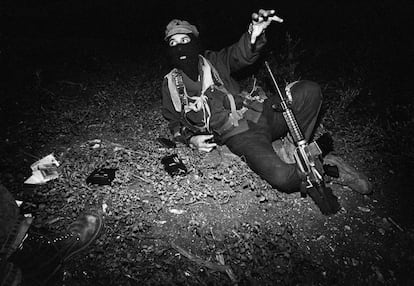
When the television cameras asked for the name and position of the spokesperson – charismatic, mysterious, shrouded in smoke – he responded: Subcomandante Marcos.
President Salinas de Gortari, however, preferred to call him a “professional of violence.” He didn’t realize the guerilla’s nickname would make history. The Mexican Army counterattacked and, for nearly two weeks, Chiapas became a war zone. The government assured the media that the conflict resulted in more than 100 deaths. Years later, the Zapatista Army of National Liberation (EZLN) lowered the number of victims: 46 Zapatistas and 27 soldiers.
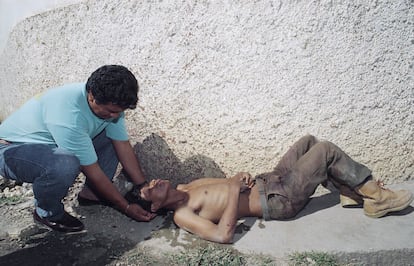
Dirty wars and the anti-globalization movement
Chiapas began to fill up with journalists. All the war reporters wanted to be there, to cover an unprecedented Indigenous uprising. The support was massive. In Mexico and abroad, thousands of people took to the streets in support of the guerrillas and to demand an end to the war. “The EZLN has a dichotomous calculation. Either the people of Mexico rise up together with us, or they finish us off, they annihilate us. If, for the rest of the country, January 1 was a surprise, for the EZLN, January 2 was a surprise… not only in Mexico but across the entire world,” Subcommantant Marcos would say many years later, in the documentary 1994, one of his last interviews to date.
The EZLN was a guerrilla movement with no track record. And while it declared war on the state, it promised to fight while respecting the Geneva Convention. The Zapatistas spoke of a miserable Mexico, in black-and-white; they described Chiapas as an enormous hacienda made up of chiefs, landowners and slaves, of a drained land and a malnourished population, dying from curable diseases. They pushed for more cutting-edge women’s rights laws than those in many Western democracies today. On the front pages of newspapers, the names of Commanders Ramona, Esther and Ana María stood out. Of course, the bias of history outlined, above all, the figure of Marcos — his caustic prose, his sharp writings, his masked charisma. Renowned intellectuals, politicians and young revolutionaries from all over the globe fell in love with him.
The Mexican Army — better-equipped and trained — surrounded the guerrillas, who took refuge in the mountains of Chiapas. But outside the region, the EZLN was sweeping the battle for public opinion. On January 12, the situation escalated to the highest point of tension for the government. The press accused the Salinas administration of deploying the indiscriminate bombing of the civilian population and other war crimes in its attempt to liquidate the rebels. The National Human Rights Commission began investigating the extrajudicial execution of five members of the EZLN.
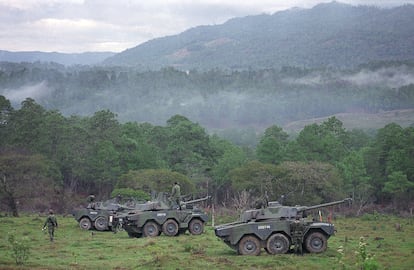
Cornered by international pressure, which was knocking on the doors of his home, President Salinas declared a unilateral ceasefire that the EZLN celebrated. The foundations began to be laid for a dialogue between the government — with Manuel Camacho Solís appointed as its representative and the guerrillas. Samuel Ruíz, then-bishop of San Cristóbal, would also participate.
Two years of disagreements followed, accompanied by the dirty war that was being waged. While both sides talked, the government developed a parallel strategy. A new president, Ernesto Zedillo, took command at the end of the year and tightened the siege on the guerrillas with a counterinsurgency campaign. More soldiers were assigned to the region, as well as paramilitary groups. Zedillo called the rebels “terrorists” and ordered their arrest. In a desperate attempt to boost the government’s public opinion polls, he unmasked the enigmatic figure of Marcos and announced his identity: Rafael Sebastián Guillén Vicente, a philosophy professor originally from Tamaulipas, who took to the mountains. But nothing worked. The influence of the EZLN continued to grow. In December of 1994, they founded 30 autonomous municipalities without firing a single shot.
The alter-globalization movement — mostly made up of youth who organized themselves in a desperate cry against globalization — looked intently toward the Zapatistas for inspiration. The EZLN was the lighthouse that illuminated the left in a dark decade. The hooded faces of Marcos and Commander Ramona became symbols of the possibility of another world that didn’t fit into G-20 summits or IMF agreements. They were the Che Guevaras of a privatized and plundered planet. An entire generation believed in the words uttered by Marcos, when he proclaimed that freedom is contagious and addictive.
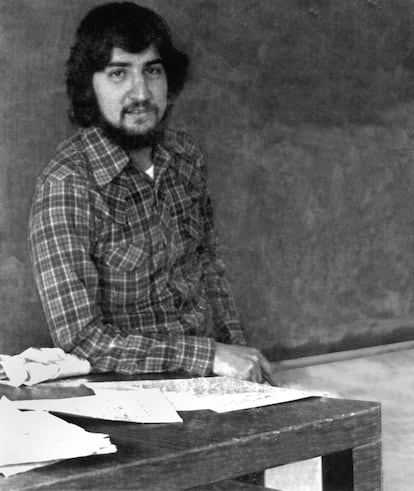
Agreements and disagreements
At the beginning of 1996, the Mexican government and the rebels signed the San Andrés Accords, a pact that promised — in the words of the EZLN — “the recognition of our free determination, our autonomy, our right to freely associate. [The right] to apply, in our spaces, the Indigenous right of the concepts of people and territory; of our right to national political representation and, in the states, to a certain basis for legal pluralism.” But President Zedillo didn’t keep his word.
The military siege and paramilitary attacks intensified. On December 22, 1997, the most infamous attack occurred. That day, a paramilitary squad entered a church in Acteal, in the highlands of Chiapas. Forty-five people were murdered in cold blood, 18 of them children. The massacre targeted Las Abejas (“the bees”), an Indigenous human rights organization. Zedillo always denied his participation in the ordering of this massacre, but two years ago, President Andrés Manuel López Obrador recognized that the Mexican government had been involved. He stated that the murderers belonged to “paramilitary groups that [had the complicity] of the authorities.”
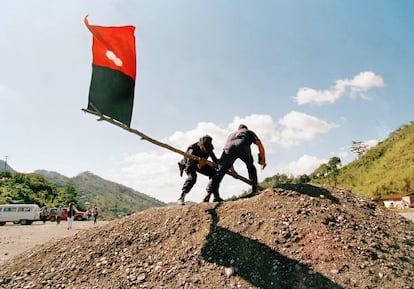
By the end of the 1990s, the Institutional Revolutionary Party (PRI) — the ossified dinosaur that had governed Mexico uninterruptedly for more than 70 years — was breaking down. In the 2000 elections, the right-wing PAN came to power, overthrowing the old party for the first time. Vicente Fox was elected president and, in a show of humility, promised to resolve the conflict in Chiapas “in 15 minutes.” The Zapatistas decided to talk to him. Subcomandante Marcos left Chiapas in a caravan with 23 other senior officials, including Commander Esther. They traveled more than 1,800 miles and, on March 10, 2001, entered the Zócalo, the main square in central Mexico City.
The bête noire of the Mexican state entered the symbolic center of national power, unarmed, aboard the trailer of a truck. He was received with songs, flowers and applause. The EZLN called the journey “The March of the Color of the Earth.” They used it to demand the autonomy of Indigenous peoples. Before the month was out, they were received in Congress — with the absence of Marcos and the 207 PAN deputies — after a tug-of-war between the parties.
Commander Esther took the stand. “My name is Esther, but that doesn’t matter now,” she began. “I am a Zapatista, but that doesn’t matter at this moment, either. I am Indigenous and I am a woman… and these are the only things that matter now.”
“This [building] is a symbol. That’s why [our appearance] sparked so much controversy. That’s why we wanted to speak here and why some didn’t want us to be here. And it’s also symbolic that I — a poor, Indigenous and Zapatista woman — am the one who speaks first,” she proclaimed. “We want our way of dressing, speaking, governing, praying, healing [to be recognized]. [We want] our way of working in groups, respecting the land and understanding life to be recognized.”
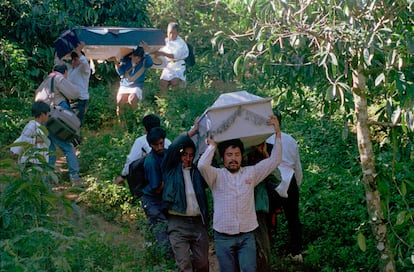
Silence, autonomy and the death of Subcomandante Marcos
The speech wrote a chapter in the Indigenous history of Mexico and the history of Mexico, in general. Esther, Marcos and the rest of the entourage returned to the mountains of Chiapas. The Congress passed a law that recognized Indigenous rights and cultures, but turned its back on their autonomy. The EZLN saw this as a betrayal and broke with parliamentary politics. For two years, silence reigned behind closed doors. In the bowels of the movement, changes were being prepared. In 2003, the EZLN announced the creation of the caracoles (“snails”) or Good Government Boards: five regions that grouped together their 39 autonomous municipalities, giving the movement a kind of civil structure.
In the years that followed, Marcos clashed with the same intellectuals who supported Zapatismo from the beginning. They reproached him for his arrogance, for having closed himself off from the outside, for not listening to anyone. The deputy commander lost part of his public influence… he fell into a sullen silence. Or, so it seemed. In 2005, the EZLN published the Sixth Declaration of the Lacandon Jungle, the definitive revision to date of the movement’s founding text. In 2006, he decided to leave Chiapas again and tour the country as part of “The Other Campaign,” a commitment to a left-wing alternative beyond the official parties that were facing each other in the presidential elections (Felipe Calderón of the PAN would win and unleash the fateful war against drugs). Marcos searched for a new way to spread the word, ask for self-governance and denounce the desolate living conditions of Indigenous peoples.
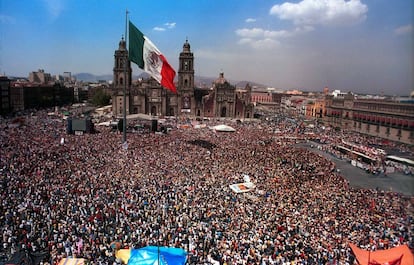
Afterwards, they took refuge in the mountains again. The organization focused on building hospitals and schools, while educating a new generation born and raised in its independent territories. For years, Marcos disappeared from the map. There were unsubstantiated rumors of a deterioration in his health. In 2014, two decades after the uprising, the deputy commander announced his own death, in a sort of metaphysical harakiri. “Through my voice, the voice of the EZLN will no longer speak,” he said. He also assumed the new name of Galeano, in honor of a murdered Zapatista teacher.
Then, he returned to silence. In 2016, the news broke that the Mexican justice system had acquitted the deputy commander formerly known as Marcos, along with 12 other members of the organization, of the charges brought forward during the Zedillo administration. A year later, the EZLN supported the independent candidacy of María de Jesús Patricio Martínez — spokesperson for the National Indigenous Congress — in the 2018 presidential elections that Andrés Manuel López Obrador ultimately won. And, in 2021 — 500 years after Hernán Cortés landed in Mexico — one of the EZLN’s delegations set sail for Europe on a sailboat to carry out “a conquest in reverse.” It sought to sow the Old World with ideas and learning, rather than death and looting.
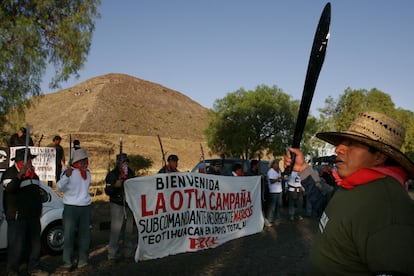
Chiapas, on the edge of civil war
The socioeconomic situation in Chiapas hasn’t improved much since 1994. It remains the lowest-income state in the country, with more than 75% of the population, mostly Indigenous and rural, living in poverty. The armed conflict of recent decades has worsened. The state never disarmed the insurgent groups and, on the contrary, reinforced militarization and the siege against the EZLN. The rise of organized crime in the region — attracted by the new drug trafficking routes from South America and the possibility of extorting money from large infrastructure projects — has unleashed a storm of violence that claims new victims every week. The guerrillas speak of a civil war that could break out again at any moment, due to the inactivity of the federal and state authorities.
In 2023 — the year that commemorated the 40th anniversary of the founding of the movement — the EZLN returned to the front pages. First, with the second metaphorical death of Marcos, who shed the name of Galeano and resumed assuming his own, although with a lower rank: insurgent captain. The guerrillas also reorganized in the mountains of southeastern Mexico with a new strategy, devised during the long years of silence. As a prelude to the 30th anniversary of the uprising, they announced the replacement of the Zapatista Rebel Autonomous Municipalities and the Good Government Boards with a more direct form of democracy, where the communities will be the basis of decision-making.
In the 21 statements the EZN has published since October of 2023 — written by Marcos and Subcomandate Moisés — one can note that there are clues of a generational change, along with a greater presence of women. In one of the texts, Moisés advised against people attending the anniversary commemoration activities, due to the widespread insecurity in Chiapas.
It’s too early to know what new direction the most iconic anti-globalization guerrilla movement will now take. For the moment, the Zapatistas are celebrating three decades of survival against the state, along with their own way of understanding politics, life, dignity and freedom. While the future of the EZLN may be uncertain, whatever happens, its past and present are part of an unprecedented fable of resistance that has forever rewritten the history of Mexico.

Sign up for our weekly newsletter to get more English-language news coverage from EL PAÍS USA Edition
